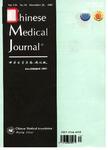Positive End-expiratory Pressure Titration after Alveolar Flecruitment Directed by Electrical Impedance Tomography
Positive End-expiratory Pressure Titration after Alveolar Flecruitment Directed by Electrical Impedance Tomography作者机构:Department of Critical Care Medicine Peking Union Medical College Hospital Chinese Academy of Medical Sciences and Peking Union Medical College Beijing 100730 China Institute of Technical Medicine Furtwangen University Jakob-Kienzle StraOe 17 D-78054 VS-Schwenningen Germany
出 版 物:《Chinese Medical Journal》 (中华医学杂志(英文版))
年 卷 期:2015年第128卷第11期
页 面:1421-1427页
核心收录:
学科分类:0831[工学-生物医学工程(可授工学、理学、医学学位)] 1004[医学-公共卫生与预防医学(可授医学、理学学位)] 081704[工学-应用化学] 07[理学] 08[工学] 0817[工学-化学工程与技术] 070302[理学-分析化学] 0703[理学-化学] 10[医学]
基 金:supported by a grant from Beijing Municipal Science and Technique Commission
主 题:Acute Respiratory Distress Syndrome Electrical Impedance Tomography Positive End-expiratory Pressure Recruitment Maneuvers
摘 要:Background: Electrical impedance tomography (EIT) is a real-time bedside monitoring tool, which can reflect dynamic regional lung ventilation. The aim of the present study was to monitor regional gas distribution in patients with acute respiratory distress syndrome (ARDS) during positive-end-expiratory pressure (PEEP) titration using EIT. Methods: Eighteen ARDS patients under mechanical ventilation in Department of Critical Care Medicine of Peking Union Medical College Hospital from January to April in 2014 were included in this prospective observational study. After recruitment maneuvers (RMs), decremental PEEP titration was performed from 20 cmH20 to 5 cmH20 in steps of 3 cmH20 every 5-10 min. Regional over-distension and recruitment were monitored with EIT. Results: After RMs, patient with arterial blood oxygen partial pressure (PaO2) + carbon dioxide partial pressure (PaCO2) 〉400 mmHg with 100% of fractional inspired oxygen concentration were defined as RM responders. Thirteen ARDS patients was diagnosed as responders whose PaO2 + PaCO2, were higher than nonresponders (419 ± 44 mmHg vs. 170 ±73 mmHg, P 〈 0.0001). In responders, PEEP mainly increased-recruited pixels in dependent regions and over-distended pixels in nondependent regions. PEEP alleviated global inhomogeneity of tidal volume and end-expiratory lung volume. PEEP levels without significant alveolar derecruitment and over-distension were identified individually. Conclusions: After RMs, PEEP titration significantly affected regional gas distribution in lung, which could be monitored with EIT. EIT has the potential to optimize PEEP titration.



